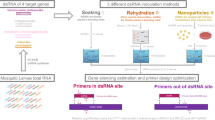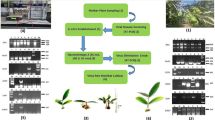Abstract
The NPVs of 3Spodoptera species and 1Heliothis species were bioassay tested for cross-infectivity. The progeny virus from the test insects was purified and examined by specific identification criteria. This demonstrated that activation of virus was much more common than cross-infection. Stress experiments using chemicals and varying environmental conditions failed to activate any virus in the stock insect cultures. Experiments were designed to test for possible mixed inoculum virus as an explanation of the activation effect but this theory was disproved.
The mechanism of the activation is unexplained but it seems clear that when independent identification techniques are used it can be demonstrated that infecting an insect larva with a NPV from another host can result in death due to infection with the NPV normally associated with that host rather than that used as inoculum. This can occur even though no latent virus can be detected in the insect population by conventional methods.
Résumé
L'infection croisée de 3 espèces deSpodoptera et d'une espèce d'Heliothis par leurs virus à polyèdres nucléaires a été étudiée en essais biologiques. Le virus issu des insectes infectés a été purifié et examiné selon des critères spécifiques d'identification. Cette étude a démontré que le phénomène d'activation d'un virus occulte est beaucoup plus fréquent que l'infection croisée. Des essais de stress par des produits chimiques et des modifications des conditions de milieu n'ont produit aucune activation dans les élevages d'insectes. La théorie expliquant l'effet d'activation par le mélange possible dans l'inoculum de plusieurs virus a été réfutée par ces expériences.
Le mécanisme de l'activation est inexpliqué, mais il paraît clair que l'emploid de techniques indépendantes d'identification permet de démontrer que la contamination d'une larve d'insecte par un virus provenant d'un autre hôte provoque une mortalité due à l'infection par le virus normalement associé avec l'espèce étudiée et non pas par celui utilisé comme inoculum. Ce phénomène peut se produire même si les méthodes classiques ne détectent pas de virus occulte dans la population de l'insecte.
Similar content being viewed by others
References
Aizawa, K. — 1963. The nature of infections caused by nuclear polyhedrosis virus. In: Insect Pathology, An advanced Treatise, vol. 1 (E. A. Steinhaus ed.) —Academic Press, New York, 381–412.
Boucias, D. G. &Nordin, G. L. — 1977. Susceptibility ofHyphantria cunea to a granulosis virus isolated fromDiacrisia virginica. —J. Invertebr. Pathol., 30, 377–380.
Burgerjon, A. — 1977. Use of specificity difference indices for the identification of nuclear polyhedrosis viruses (Baculovirus) of insects. —Entomophaga, 22, 187–192.
Burgeron, A., Biache, G. &Chaufaux, J. — 1975. Recherches sur la spécificité de trois virus à polyhèdres nucléaires vis-à-vis deMamestra brassicae, Scotia segetum, Trichoplusia ni, etSpodoptera exigua. —Entomophaga, 20, 153–160.
Finney, E. J. — 1962. Probit Analysis. —Cambridge Univ. Press, Lond. & N. Y.
Harper, J. D. — 1976. Cross infectivity of six plussine nuclear polyhedrosis virus isolates to six plussiine hosts. —J. Invertebr. Pathol., 27, 275–277.
Harrap, K. A., Payne, C. C. &Robertson, J. S. — 1977. The properties of three baculoviruses from closely related hosts. —Virology, 79, 14–31.
Ignoffo, C. M. — 1966. Susceptibility of the first instar of the bollowrmHeliothis zea and the budwormHeliothis virescens toHeliothis NPV. —J. Invertebr. Pathol., 8, 531–536.
Litchfield, J. T. — 1949. A method for rapid graphic graphic solution of time per cent effect curves. —J. Pharmacol. Exp. Ther., 97, 399–408.
Longworth, J. F. &Cunningham, J. C. — 1968. The activation of occult nuclear polyhedrosis viruses by foreign nuclear polyhedra. —J. Invertebr. Pathol., 10, 361–367.
Maleki-Milani, H. — 1978. Influence de passages répétés du virus de la polyédrose nucléaire deAutographa californica chezSpodoptera littoralis [Lep.: Noctuidae]. —Entomophaga, 23, 217–224.
Maruniak, J. E., Summers, M. D., Falcon, L. A. &Smith, G. E. — 1979.Autographa californica nuclear polyhedrosis virus structural proteins compared fromin vivo andin vitro sources. —Intervirology, 11, 82–88.
Smith, K. M. — 1976. Virus-Insect Relationships. —Longman London.
Tompkins, C. J., Adams, J. R. &Heimpel, A. M. — 1969. Cross-infection studies withHeliothis zea using nuclear polyhedrosis viruses fromTrichoplusia ni. —J. Invertebr. Pathol., 14, 343–357.
Vail, P. V., Sutter, G., Jay, D. L. &Gough, D. — 1971. Reciprocal infectivity of cabbage looper and alfalfa looper nuclear polyhedrosis viruses. —J. Invertebr. Pathol., 17, 383–388.
Vail, P. V., Jay, D. L. &Hunter, D. K. — 1973. Infectivity of a nuclear polyhedrosis virus from the alfalfa looper,Autographa californica, after passage through alternate hosts. —J. Invertebr. Pathol., 21, 16–20.
Author information
Authors and Affiliations
Rights and permissions
About this article
Cite this article
McKinley, D.J., Brown, D.A., Payne, C.C. et al. Cross-infectivity and activation studies with four baculoviruses. Entomophaga 26, 79–90 (1981). https://doi.org/10.1007/BF02371836
Issue Date:
DOI: https://doi.org/10.1007/BF02371836




